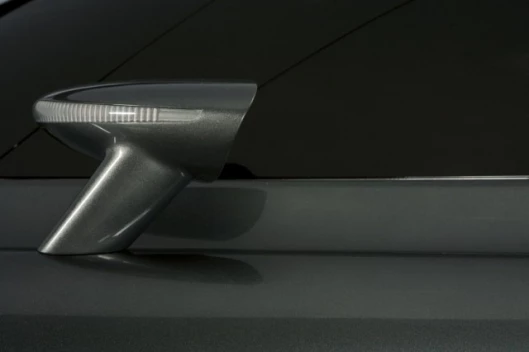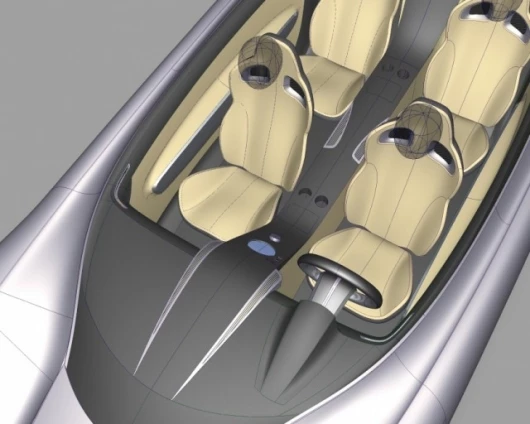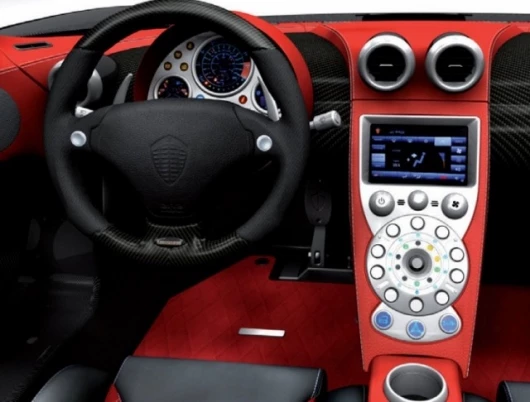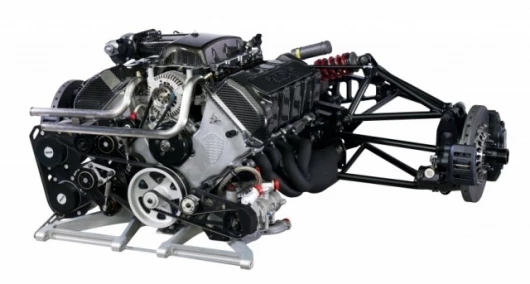March 6, 2009 Swedish supercar manufacturer Koenigsegg, in conjunction with NLV Solar of Switzerland, is showing its full scale four-seater NLV Quant at the 2009 Geneva Salon. Producing 512hp with maximum torque of 715Nm, the Quant runs 0–100 km/h in 5.2 seconds and hits a top speed of 275 km/h. The all-electric car is powered through a combination of what it has dubbed a Flow Accumulator Energy Storage (FAES), which charges to full capacity in 20 minutes, and solar energy supplied via a thin layer photovoltaic coating over the car. The combined solar/FAES offer a claimed range in excess of 500km.
The NLV Quant
New technology
The thin layer solar technology and the proprietary FAES system enable the design of a fully electrical vehicle, rather than relying on more commonplace hybrid solutions. This also simplifies the drive train layout and packaging, as only one propulsion system is needed.
Koenigsegg says that the Quant will be able to cover long distances without a charge due to a combination of a low frontal surface area of around 2 m2, a drag coefficient of around CD 0.27 and the efficiency of the FAES and solar systems.
Style
The ingenious design provides a unique blend of supercar looks and the space of a traditional luxury sedan. The car will carry four large adults in comfort and also feature a spacious boot at the rear.
The gull-wing doors on the Quant allow for an easy and more ergonomic access to both the front and rear passenger seats than in conventional cars. The unique split side-lite feature allows passenger to open and close the front and rear side windows separately.
Standard features
The NLV Quant is a rear-wheel drive, with four-wheel regenerative braking (no details yet on how the front captures energy), ABS and ESP. It is powered by two AC induction electric motors with variable frequency drive and in-line planetary step down drive, one for each rear wheel. The twin-motor design eliminates the need for bevel gears or a differential, simplifying the lay-out and giving constant and controlled power proportioning to the rear wheels, in both drive and coast mode.
A projected curb weight of 1780 kg is achieved by a combination of the two-motor installation which weighs in at 140 kg and a carbon-fiber monotube backbone chassis, construction, which houses the FAES system. The FAES weighs around 450 kg and Koenigsegg advises that it contains no hazardous material or heavy metals.
Preliminary Specs
- Power: 512 bhp
- Torque: 715 nm
- 0–100 km/h: 5.2 seconds
- Top speed: 275 km/h
- Curb weight: 1780 kg
- Wheelbase 3102 mm
- Track – Front: 1730 mm Rear: 1729 mm
- Wheels/Tires – Front: 245/35 - 22” , Rear: 265/35 - 22” - low friction tires by Michelin
- Width: 2016 mm incl rear-view mirrors, Length: 4879 mm, Height: 1335 mm
- Rear-wheel drive
- Four-wheel brake regeneration
- Minimum 6 smart airbags, ABS and ESP
- 3 infotainment panels(one in front, two for the rear)
- Adjustable rear seats
- 3 zone Climate Control system
- Large leg room in the rear
- LED front and rear lights
- Body covered in NLV photovoltaic thin flm solar coating
- NLV mobile redox Flow Accumulator Energy Storage system - FAES
- Space for 4 full grown individuals
- Price: TBD
New Technologies to be introduced by Koenigsegg at the Geneva Auto Salon
In addition to the Quant, Koenigsegg will introduce a new touch screen infotainment system, a fast ATM paddle gear shift system and an electronic differential at the Geneva Auto Salon this year.
The touch screen Infotainment system features are:
- Global Sat Nav
- Bluetooth telephone
- Performance mode - G-force meter, lap timer, power Torque meter
- Climate control
- Music system, with radio and I-pod control
- Outdoor temp
- Warning and Hazard displays
- Setup control for: Chassis, Traction control, Paddelshift etc.
- GPS controlled interior lighting and music volume
The Infotainment system is modular and can be upgraded over time. For example, it will be possible for drivers to record lap times, power levels and G-forces. On the CCXR model it will be possible to read ethanol mixture and how much this effects the power level.The ATM Paddelshift system features a new gearbox design, which has been developed for the CCX. The gearbox is engineered to take up to 1100 nm of torque and due to its transversal layout, it is about 30 cm shorter then the manual transaxle gearbox it replaces, which improves weight distribution, says Koenigsegg. They go on to say that the gearbox features a synchronization system that allows shift times of 30 milliseconds - a great improvement, compared to existing synchromesh system. Basically it is as fast as a dual clutch transmission, but reduced in size and weight – two important factors in a Supercar, says Koenigsegg.
The gearbox also includes an electronic differential control. Koenigsegg says that the E-diff, makes the car easier to drive on the limit of performance, and thereby enhances the experience to most drivers. The gearbox is controlled with ergonomic paddles mounted on the steering wheel. Koenigsegg believes this to be the most optimal solution, as the paddles follow the steering wheel movements at all times.
Wrap up
We see the NLV Quant providing a benchmark for super cars into the future. It combines speed, comfort and enjoyment with environmental integrity. Given the vulnerability and price volatility of oil-based automotive fuels, having an all-electric power plant makes good sense. This new car allows for the design and performance from a supercar manufacturer Koenigsegg, to be featured with the latest developments in the thin layer photovoltaic technology provided by NLV Solar.
For more information refer to NLV Solar AG and Koenigsegg.
David Greig































